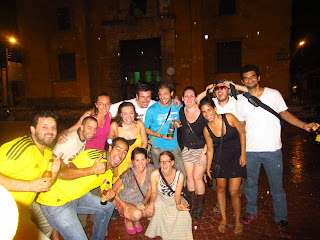The "When I Grow Up Project" is officially up and running! Well, half way there--working on setting up an an account in Colombia/with my high school so that Colombians can donate (in the end, this is maybe the most important aspect). The ultimate goal is to
get more low-income students to attend and graduate from university. I
believe 100% in this project.
I work at Soledad
Roman de Nunez, a large, public high school in Cartagena, Colombia. Most of my
students come from the lowest socio-economic conditions of extreme poverty. However, despite challenges and
temptations (gangs, racism, displacement, malnutrition, violence, and a
struggling school system, among others), there are students who rise above
these circumstances. They define “inspirational”. Highly intelligent and
driven, they will excel in higher education. They want to attend university,
not just for personal profit, but also to help their families and communities,
confronting issues that they understand and are empowered to change. However,
regardless of overcoming so much, many capable students do not even
apply to university because the entrance exam fee alone is too expensive. Furthermore,
if they do enroll, many will not be able to pay for transportation, new clothes,
or lunch in order to save money for school supplies and tuition. In the end,
lack of money is what stops them from reaching their "When I Grow Up"
dreams, nothing else. The cycle of poverty endures.
After months of
designing the project with teachers, social workers, and university
professors, we have partnered with NBC
Children's Fund, an NGO started by a returned Peace Corps Volunteer,
Carolyn Carpenter.
Together, we hope to give
these children the opportunity they deserve and to stop the cycle of poverty by
funding the following:
1. To offer a
preparatory course to help students pass the University of Cartagena entrance
exam. (Cost per student: $20)
2. To cover the cost
of the entrance exam fee for those students who pass the preparatory course
described above. (Cost per student: $50).
3. To finance 75% of
the first year’s tuition at the University of Cartagena. (Cost per student:
$500).
To donate:
1. Visit NBC Children’s Fund’s website and donate via pal-pal.
http://nbcchildrensfund.org
1. Visit NBC Children’s Fund’s website and donate via pal-pal.
http://nbcchildrensfund.org
2. Send a check to NBC Children’s Fund, specifying the
“When I Grow Up Project”, to the following address (therefore 3% of donations
will not be lost to credit cardcompanies):
NBC Children’s
Fund
211 Roslindale Ave. #2
Boston, MA 02131
211 Roslindale Ave. #2
Boston, MA 02131
The goal of the
project is to have 20-25 students from my school take the preparatory course
and apply to the University of Cartagena in addition to financing 75% of the
first year’s tuition for 2-4 students. Only students from the lowest
socio-economic classes are eligible. At least 50% of participants will be
female and 20% of Afro-Colombian descent.
If sufficient funds
are raised and the goals described above are met, additional public high
schools in Cartagena where a Peace Corps volunteer is present may also receive
funding, therefore incorporating additional students and making an impact
throughout the city.
Finally, the “When I
Grow Up Project” and all its donations are in honor of my mom, Joan Kuntz. Passion,
altruism and determination are traits possessed by Joan and many students at
Soledad Roman de Nunez. People with these qualities have the potential for
positive impact, whatever their nationality, socio-economic status or culture.
Joan exemplifies that taking the risk to be the change she wishes to see in the
world can make all the difference in one’s own life and that of others. She
embodies the importance of education and, like many students at Soledad Roman
de Nunez, is an inspiration to her family, friends, colleagues, and students.
Make sure to check
out our video on the NBC Children’s Fund website or on youtube:
*Make sure to click CC for English subtitles*
Also, if you have
facebook, like and join our cause:
The holiday season in particular is
a time to realize how fortunate we are and to give back. Want to give a gift
that can truly change a life?—Please donate to the “When I Grow Up Project” and
share it with other family and friends.



















































